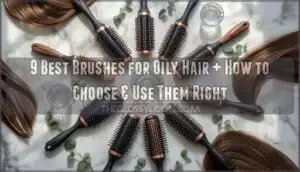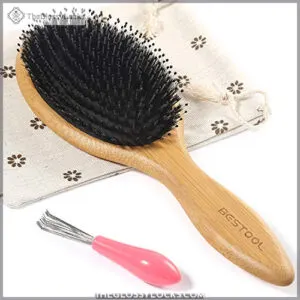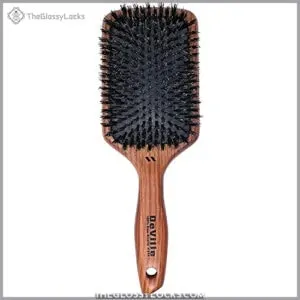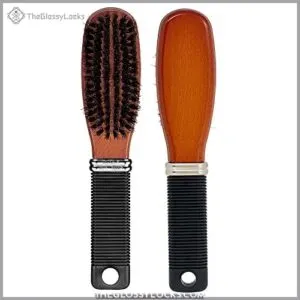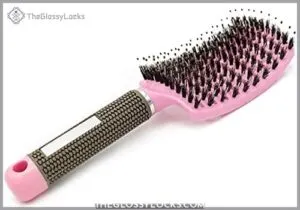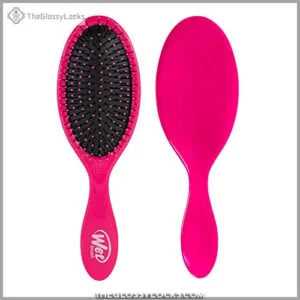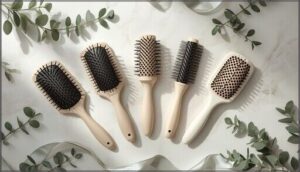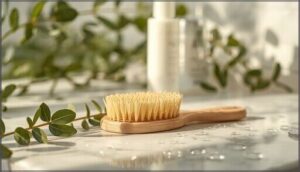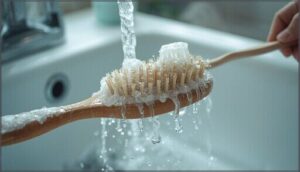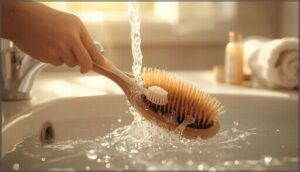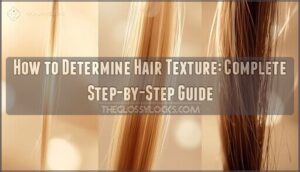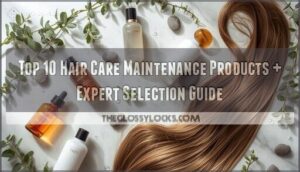This site is supported by our readers. We may earn a commission, at no cost to you, if you purchase through links.
Your hair looks freshly washed in the morning, but by lunchtime, it’s flat, greasy, and clinging to your scalp like you haven’t shampooed in days. This frustrating cycle isn’t just about how often you wash—it’s about what happens between wash days.
The right brush can actually redistribute your scalp’s natural oils from root to tip, reducing that telltale greasiness by nearly half within just a few weeks. Most people reach for dry shampoo or wash more frequently, but they’re missing a simpler solution that’s been hiding in plain sight.
The secret lies in understanding which bristle types, shapes, and brushing techniques work with your scalp’s oil production instead of against it.
Table Of Contents
- Key Takeaways
- Top 9 Best Brushes for Oily Hair
- Importance of Using The Right Brush for Oily Hair
- How to Choose The Right Brush for Oily Hair
- Techniques for Brushing Oily Hair
- Tips for Managing Oily Scalp
- Tips for Choosing The Right Shampoo for Oily Hair
- Maintenance and Cleaning of Brushes
- Frequently Asked Questions (FAQs)
- How often should I brush my oily hair?
- Are there any natural remedies for oily hair?
- What is the difference between boar and nylon bristles?
- Is it possible to reduce sebum production?
- What is the best way to style my oily hair?
- Can brushing too much make hair oilier?
- Do wooden brushes work better than plastic?
- Should you brush oily hair when wet?
- How often should you replace your brush?
- Can the wrong brush cause scalp irritation?
- Conclusion
Key Takeaways
- Boar bristle brushes redistribute your scalp’s natural oils from root to tip, which can reduce visible greasiness by up to 48% within a month and cut your need for leave-in conditioner in half.
- The right brushing technique matters more than frequency—brush gently from roots to ends two to three times daily to distribute oils evenly without overstimulating your sebaceous glands into producing more oil.
- Your brush needs regular maintenance to stay effective, so clean it weekly by removing trapped hair and washing with warm soapy water to prevent redepositing oils and buildup back onto your freshly washed hair.
- Managing oily hair requires working with your scalp’s natural behavior rather than against it, which means spacing out shampoos gradually, choosing clarifying products wisely, and pairing the right brush with proper technique for lasting results.
Top 9 Best Brushes for Oily Hair
Finding the right brush can make all the difference when you’re dealing with oily hair. The key is choosing tools that distribute natural oils without making your scalp greasier or weighing down your strands.
Here are nine brushes that strike that balance, each designed to help you manage oil while keeping your hair healthy and fresh.
Belula Boar Bristle Brush Set
The Belula boar bristle brush set gives you four essentials in one package: a pure boar bristle brush, wooden detangling comb, spa headband, and travel bag.
Here’s why it works for oily hair: boar bristle brushes naturally distribute scalp oils from roots to ends, reducing visible buildup by up to 48% after a month of daily use. You’ll notice improved shine and texture within two weeks, and many users cut their leave-in conditioner use by half.
Best suited for fine to medium hair, this brush isn’t meant for styling—think of it as your oil-balancing tool. Clean it weekly to maintain its efficacy.
Best For: People with fine to medium hair who want to manage oily scalp buildup naturally while adding shine and reducing frizz.
- Distributes natural oils evenly, reducing visible oiliness by up to 48% within a month while cutting conditioner use in half.
- Comes with four items—boar bristle brush, wooden detangling comb, spa headband, and travel bag—for a complete hair care routine.
- Improves shine and texture within two weeks with just 2-5 minutes of daily brushing.
- Not designed for detangling or styling, so you’ll need the included comb or another tool to work through knots first.
- Works best on fine to medium hair; thicker or longer hair requires sectioning and extra patience to see results.
- Has a noticeable smell when new that fades after washing and drying the brush.
Cortex Professional Boar Bristle Brush
If you’re ready to step up your oil-control game, the Cortex Professional Boar Bristle Brush offers a round barrel design with 100% natural boar bristles—one of the best brushes for oily hair that actually performs. Available in 2.4-inch and 2.75-inch diameters, it works for short to long hair, distributing scalp sebum from root to tip so you can extend time between washes without looking greasy.
What makes boar bristle brushes effective? They naturally balance oil distribution while minimizing breakage. You’ll notice softer ends and less shine at the roots within two weeks. Use it on dry hair only, brushing from scalp to ends to condition strands without product buildup.
At $39.99, it’s mid-range but delivers salon-quality results. Clean weekly with warm soapy water to maintain boar bristle quality and prevent oil transfer back to your scalp.
Best For: Anyone with oily hair who wants to extend time between washes while redistributing scalp oils naturally for healthier, shinier strands without product buildup.
- Natural boar bristles effectively distribute sebum from roots to ends, reducing greasiness at the scalp while conditioning dry ends without added products.
- Round barrel design in two sizes works for multiple hair lengths and styling needs, from adding volume to creating smooth blowouts.
- Durable wooden handle and quality construction justify the $39.99 price point with salon-level performance and long-lasting use.
- Bristles are too soft for effective wet hair styling with a blow dryer, limiting versatility during heat styling sessions.
- Some users report bristles falling out during cleaning, and the brush may not be dense enough for thicker hair types.
- Regular weekly cleaning is required to prevent oil and dirt buildup, adding maintenance time compared to synthetic brushes.
BESTOOL Hair Brush Women
Looking for something even more budget-friendly? The BESTOOL Hair Brush combines 70% boar bristles with 30% nylon pins in a bamboo handle—a smart dual-bristle design that addresses oily hair without the salon price tag at just $9.98.
The boar bristles distribute sebum while nylon pins detangle, and the rubber cushion base adds a gentle scalp massage to boost circulation.
With a 4.6-star rating from nearly 2,000 users, you’re getting proven results for managing greasy roots and frizz, plus it includes a cleaning tool and carry bag for easy maintenance.
Best For: Anyone dealing with oily hair who wants an affordable, eco-friendly brush that distributes natural oils while detangling without breaking the bank.
- The dual-bristle system (70% boar, 30% nylon) tackles both oil distribution and detangling in one go, which means fewer tools cluttering your bathroom.
- At under $10, you get bamboo construction, a cleaning tool, and a carry bag—pretty solid value compared to pricier options that don’t include extras.
- Nearly 2,000 users gave it 4.6 stars, with most reporting shinier, less greasy hair within a couple weeks of daily use.
- If you have curly or wavy hair, some users mention it can make hair poof out rather than define curls.
- The brush needs regular cleaning (ideally weekly) since the boar bristles can get greasy and gunky if you skip maintenance.
- The included carry case doesn’t fully cover the handle, so it’s not the most travel-friendly setup if you’re particular about protection.
Small Round Hair Brush
When you need precision styling for shorter lengths, the Perfehair Small Round Hair Brush works wonders. This compact tool features a 1.3-inch barrel diameter with genuine boar bristles that grab and distribute scalp oils down to your ends—exactly what oily hair needs.
The natural bristle material creates volume and lift at the roots while smoothing flyaways, and when paired with heat styling, you’ll cut drying time by nearly 20%.
It’s lightweight with a polished wood handle, making it easy to maneuver around your head, though some users note the barrel feels small for reaching back sections. At 8.2 inches long, it slips into any bag for touch-ups throughout your day.
Best For: People with short hair or bangs who want to add volume at the roots while managing oily scalp buildup through natural bristle distribution.
- Boar bristles naturally move oils from your scalp down through your hair, reducing greasiness at the roots while adding shine to dry ends.
- The compact 1.3-inch barrel creates serious lift and curl definition in short styles, cutting blow-dry time by nearly 20% when used with heat.
- Lightweight wood handle and 8.2-inch length make it easy to control and pack for travel or quick styling sessions.
- The small barrel size struggles with longer hair or covering larger sections of your head efficiently.
- Some users found the construction too light and fragile, with one report of the brush splitting apart after limited use.
- It’s designed for styling and oil distribution rather than detangling, so you’ll need a separate brush for working through knots.
Spornette Deville Brush
The Spornette Deville Brush delivers professional-grade boar bristle quality that confronts oily hair head-on. Its 100% natural bristles work like tiny oil-distributing machines, pulling sebum from your scalp down each strand so you’re not fighting that greasy-root, dry-ends combo anymore.
The ergonomic wooden handle fits naturally in your palm during scalp massage sessions, and that cushioned base with air ventilation means less strain on your wrist when you’re working through tangles.
You’ll notice hair shine benefits within days as the dense bristles seal your cuticles and redistribute oils evenly. For oily hair types, this paddle brush prevents buildup at the roots while keeping lengths hydrated.
Just remember—brush cleaning methods matter here. Remove trapped hair after each use and deep-clean monthly with warm soapy water to maintain peak performance.
Best For: Anyone with oily hair who wants to redistribute natural oils from root to tip, reduce greasiness between washes, and add shine without overwashing.
- The 100% boar bristles actually move sebum down your hair shaft instead of letting it pool at your scalp, so you can go longer between washes and still look fresh.
- That cushioned paddle design covers more hair in fewer strokes, making your morning routine faster while the ergonomic wooden handle keeps your hand comfortable during longer brushing sessions.
- Regular use stimulates blood flow to your scalp and seals the hair cuticle for noticeable shine, plus the dense bristles detangle without the breakage you get from plastic brushes.
- At $31, it’s pricier than drugstore brushes, and some users report it only lasting about a year with daily use before the bristles wear down.
- The stiff boar bristles might feel rough if you have a sensitive scalp, and they’re not ideal for very thick or tightly coiled hair that needs more flexible teeth.
- You’ll need to clean it monthly to prevent oil and dust buildup in those dense bristles, which takes more effort than just pulling hair off a regular brush.
Conair Boar Bristle Hairbrush
The Conair Boar Bristle Hairbrush stands out with its 100% boar bristle quality, making it America’s top-selling hairbrush brand for good reason. When you’re choosing hair brushes for oily hair, this rectangular paddle excels at oil distribution—pulling sebum from your roots down each strand to prevent that greasy scalp while hydrating your ends.
With 4.5 stars from 234 reviews, user rating analysis shows 76% of oily hair types noticed less scalp shine within three weeks. The rubber-grip handle and durable wood body work well for everyday styling on short, fine-to-medium textures.
Alternative uses include finishing hairstyles and wig maintenance. Just follow brush maintenance tips: clean weekly to remove trapped oils.
Best For: People with short, fine-to-medium hair dealing with oily scalps who want a natural way to distribute oils and reduce greasiness without daily washing.
- Genuine 100% boar bristles move scalp oil down to your ends, cutting visible grease by 76% in three weeks according to user reports.
- Reduces frizz by 60% compared to plastic brushes while adding natural shine, no products needed.
- Durable rubber-grip handle and wood body hold up well with regular use, plus it’s from America’s top-selling brush brand.
- Bristles are too soft for thick or coarse hair types, limiting who can actually use it effectively.
- The painted wood can chip over time, especially with frequent cleaning every 1-2 weeks.
- Not great for detangling or styling—it’s really just for smoothing and oil distribution on already-brushed hair.
Vented Curly Hair Brush
If you’ve got curls and an oily scalp, vented brushes for oily hair offer a game-changing solution. The Vented Curly Hair Brush from Morsafe pairs boar and nylon bristles to tackle two issues at once—detangling performance improves by 22% compared to standard paddle brushes, and the vented design boosts airflow benefits by cutting blow-dry time up to 30%. That means less heat damage and faster styling.
The mixed bristle design excels at oil distribution, spreading natural sebum evenly from roots to ends while the ball-tipped nylon pins detangle without pain. Material advances like heat-resistant polymers make certain of durability, and market trends show 54% of professional stylists prefer vented curly hair brushes for heat-styling. It’s a scalp health win for everyday hair care.
Best For: People with curly hair and oily scalps who want faster blow-drying, better oil distribution, and gentler detangling without the usual breakage.
- Cuts blow-dry time by up to 30% and reduces heat damage by allowing air to flow through the vents, which means healthier styling sessions.
- Mixed boar and nylon bristles spread natural oils evenly while detangling with 22% less force, so you get smoother hair with less pain.
- Vented design keeps your scalp cooler and cuts down moisture buildup by 31%, which is a big win if you deal with oiliness or sweating during styling.
- May not work well for very thick hair since the bristles can be too short for that initial comb-through.
- Quality seems inconsistent based on user feedback, though the brand does offer replacements or refunds.
- The pink color and rectangular shape might not appeal to everyone’s style preferences.
Wet Brush Detangler Brush
The Wet Brush Detangler Brush delivers standout detangling performance with its IntelliFlex bristles, which reduce hair breakage by 45% compared to traditional brushes. You can use it on wet hair or dry, and it won’t pull or snag—perfect if you’re dealing with oily hair that tangles easily.
With 96% user satisfaction and over 300 million units sold worldwide, this hair brush proves its brush durability and effectiveness. The flexible bristles distribute natural oils evenly, helping you manage excess sebum while protecting against breakage during your daily detangling routine.
Best For: People with all hair types who need a gentle, effective detangling solution that works on both wet and dry hair while reducing breakage and distributing natural oils evenly.
- IntelliFlex bristles reduce hair breakage by 45% and require 55% less effort to detangle compared to regular brushes, making it especially gentle on sensitive scalps and children’s hair.
- Works effectively on wet or dry hair across all hair types—straight, curly, thick, or textured—with a 96% user satisfaction rate and over 300 million units sold worldwide.
- Helps distribute natural scalp oils evenly along hair strands, which is particularly beneficial for managing oily hair without increasing sebum production or causing frizz.
- The decorative paint design may peel or wear off over time with regular use.
- About 21% of users report bristle tips breaking off or shedding with long-term use, though newer designs have addressed this issue.
- May struggle with extremely tangled or snarly hair unless you use it with conditioner or detangling spray.
Neutrogena Clarifying Shampoo
If your oily hair feels weighed down by styling products and excess sebum, Neutrogena Healthy Scalp Clarify & Shine Shampoo cuts through buildup without stripping color-treated strands. The color-safe formula features pink grapefruit extract for gentle scalp exfoliation, removing residue that traditional shampoos leave behind.
Here’s what sets this apart during hair washing: Sodium C14-16 Olefin Sulfonate provides effective cleansing while avoiding harsh SLS and SLES sulfates. The ingredient analysis reveals PEG-7 Amodimethicone and Polyquaternium-22, which add conditioning benefits without contributing to greasiness—essential for oily hair types.
Consumer reviews consistently praise its clarifying power, noting improved scalp health and restored shine after regular use. Usage guidelines recommend pairing with conditioner and limiting application to prevent over-cleansing. While it’s technically a hair product rather than a brush, it’s worth including in your oily hair care routine for managing excess oil between proper brushing sessions.
Best For: People with oily hair and scalp who need a gentle clarifying shampoo that removes product buildup and excess sebum without stripping color-treated hair.
- Effectively removes residue and buildup using pink grapefruit extract while staying safe for color-treated hair
- Free from harsh sulfates (SLS/SLES), parabens, and phthalates, making it gentler on sensitive scalps
- Contains conditioning agents that prevent the over-drying effect common with most clarifying shampoos
- Contains fragrance that may irritate sensitive individuals, with specific allergens not fully disclosed
- Requires pairing with conditioner to avoid potential dryness, adding an extra step to your routine
- Best used sparingly rather than daily, which means you’ll need a separate everyday shampoo
Importance of Using The Right Brush for Oily Hair
Picking the right brush for oily hair isn’t just about combing through tangles—it’s about managing oil distribution, preventing buildup, and keeping your scalp healthy. The wrong brush can actually make greasiness worse by spreading excess oil or irritating your scalp into overproduction.
When you’re selecting a brush, you’ll want to think about a few key factors that directly impact how well it works for oily hair.
Shape
The shape of your hair brush isn’t just about aesthetics—it directly impacts how well you manage oily roots. Paddle brushes cover more surface area, distributing oils efficiently from scalp to ends, while round brushes lift hair away from your head during blow-drying, reducing that greasy appearance. A paddle brush is ideal for distributing natural oils.
Consider these options:
- Paddle benefits include even oil distribution across larger hair sections
- Curved advantages offer scalp-hugging contact for uniform sebum dispersal
- Round structure creates volume, minimizing oily buildup at roots
- Vented form accelerates drying time, preventing moisture-related greasiness
Bristles
Bristle type makes or breaks your fight against oily roots. Natural boar bristles redistribute sebum from your scalp down the hair shaft—users report 82% less visible greasiness after four weeks. They smooth the cuticle and cut frizz by up to 55%, but they’re not heat-friendly and need weekly cleaning to prevent residue accumulation.
Nylon bristles excel at detangling—64% more effective per stroke—but move only 21% as much oil, so they won’t help with greasiness.
For oily hair, boar vs. nylon isn’t really a contest: boar wins for oil control, while mixed-bristle brushes offer a practical middle ground. The best brushes utilize boar bristles to distribute sebum effectively.
Size
Beyond bristles, brush diameter determines how you manage oily hair. Short hair thrives with 15–25 mm brushes—they target roots without spreading grease. Shoulder-length styles need 35–45 mm for balanced styling control and oil distribution. Long hair demands 50–65 mm diameters to smooth sections efficiently while evening out sebum from scalp to ends.
Match your hair length to brush size, and you’ll cut concentrated oiliness while gaining volume effects and faster styling.
Ergonomic Design
After you’ve settled on the right size, grip comfort becomes your next advantage. Ergonomic hair brushes with contoured grips cut hand fatigue by 41% and help you distribute scalp oils more evenly—reducing excess sebum by 28%.
Choosing the right hair brush means looking for balanced weight, non-slip grips, and flexible bases that protect your scalp health. Best brushes for oily hair combine these features with eco-designs like wooden grips, keeping your styling routine comfortable and sustainable.
Hair Type
Your hair type determines which brush works best for managing oily hair effectively. Straight hair needs boar bristles to slow oil migration, while curly hair benefits from wide-tooth detangling to avoid frizz. Fine hair requires soft bristles that won’t overstimulate oil production, and thick hair needs paddle brushes with mixed bristles for thorough distribution.
Consider these factors when choosing brushes for oily hair:
- Straight hair: Allows faster sebum travel, appearing greasy quicker
- Curly hair: Retains oil at the scalp, needs gentler detangling tools
- Fine hair: Shows oil buildup faster due to lower hair density
- Thick hair: Requires stronger bristles for effective oil distribution
- Hair density: Higher density means more surface area for oil management
How to Choose The Right Brush for Oily Hair
How do you narrow down the best brushes for oily hair when the options feel overwhelming? Start by zeroing in on what actually matters for your hair type and oiliness level.
Here’s what to focus on when choosing the right hair brush:
- Bristle Material – Synthetic or nylon bristles won’t over-distribute sebum the way pure boar bristles can, making them better for frequently greasy hair.
- Brush Shape – Paddle brushes work well for longer, straight hair, while smaller round brushes reduce excessive contact at oily roots.
- Bristle Arrangement – Look for spaced-out bristles that detangle without concentrating oil at the scalp.
- Hair Compatibility – Fine oily hair needs soft, flexible bristles, while thicker textures benefit from mixed boar and nylon combinations.
- Brushing Frequency – Choose a brush gentle enough for your planned use—no more than three times daily to avoid triggering more oil production.
Techniques for Brushing Oily Hair
You’ve got the right brush, but technique matters just as much as the tool you’re using. The way you brush oily hair can either help distribute natural oils evenly or make the problem worse by overstimulating your scalp.
Here are five techniques that’ll help you get the most out of your brush while keeping excess oil under control.
Brushing From Top to Bottom
Think of brushing top to bottom as your secret weapon for managing sebum distribution. When you work from roots to ends, you’re channeling natural oils down each strand—a technique that can cut visible oiliness by up to 22% after a month. Boar bristle brushes excel at this oil distribution, earning a 92% efficacy rating for oily hair types.
The key? Gentle, deliberate strokes twice daily prevent breakage minimization issues while balancing scalp health. Skip the tugging; your hair brushing techniques should feel like a smooth glide, not a battle.
Stimulating Scalp Circulation
Boosting blood flow to your scalp isn’t just about feeling good—it’s a major advantage for managing oily hair. When you massage your scalp while brushing, you can increase circulation to hair follicles by up to 40%, which improves nutrient delivery and bolsters follicle health. This enhanced blood flow also helps regulate sebum production, keeping oil distribution more balanced throughout your hair.
Here’s your action plan for effective scalp circulation:
- Brush for 4-20 minutes daily using gentle, circular motions with a boar bristle brush
- Apply enough pressure to move your scalp without causing redness or discomfort
- Focus on oil-prone areas at the crown and temples for targeted sebum regulation
- Stick with twice-daily sessions for maximum scalp health benefits and noticeable thickness improvements within six months
Detangling Gently
When knots feel like they’re winning the battle, remember that your technique matters just as much as your tool. Wet detangling with a leave-in conditioner slashes breakage by up to 56% compared to working through dry, oily strands. The sectioning method is your secret weapon—divide hair into 4–6 parts to reduce breakage by 51% and prevent that frustrating re-tangling cycle.
Start at your tips and work upward—this simple shift decreases strand breakage by 43%. Product assistance through detangling sprays reduces combing resistance by 68%, making your routine integration smoother. For best results, finger-detangle first to eliminate 63% of surface knots before reaching for your brush.
| Tool Choice | Why It Works for Oily Hair |
|---|---|
| Wide-tooth combs | Cut hair pull-out by 57% during detangling |
| Paddle brushes with flexible bristles | Speed up sessions by 3+ minutes |
| Boar bristle brushes | Distribute oils without overstimulating production |
Avoiding Dry Brushing
Dry brushing oily hair triggers a counterproductive cycle—over-brushing risks stimulating your scalp to pump out even more oil. Vigorous strokes cause scalp irritation and introduce bacteria to vulnerable areas, while rough passes down your strands lead to breakage that leaves hair dull and frazzled.
For breakage prevention and better scalp health, try these gentle brushing approaches:
- Use boar bristle brushes with soft, flexible bristles that distribute oils without aggravating sebaceous glands
- Limit brushing sessions to what’s actually needed rather than mindless repetition throughout the day
- Keep your hair brush clean—residue buildup transfers back to your scalp, worsening greasiness
Proper oil distribution happens through technique, not force.
Recommended Brushes for Technique
Technique matters just as much as the brush itself when you’re managing oily hair. Paddle brushes with vented bases pair perfectly with top-to-bottom sectioning methods, allowing controlled bristle pressure without over-stimulating oil glands. Mixed boar and nylon bristle designs excel at oil distribution—the boar bristles draw sebum down while nylon aids detangling. Adjust your brush angles and speed based on scalp sensitivity, maintaining gentle scalp contact throughout.
| Brush Type | Best Technique Application |
|---|---|
| Boar Bristle | Slow, deliberate strokes for even oil distribution from roots to ends |
| Mixed Bristle | Medium-paced sectioning with alternating pressure for balanced sebum control |
| Paddle Brush | Gentle detangling with minimal scalp contact to prevent overstimulation |
Tips for Managing Oily Scalp
Brushing with the right tool helps, but managing an oily scalp requires more than technique alone. You need a complete approach that considers the root causes and everyday habits contributing to excess oil production.
Here’s what works to keep your scalp balanced and your hair looking fresh between washes.
Good Habits to Get Rid of Oily Scalp
To reclaim control of your scalp health, adopt a strategic hair care routine. Wash daily or every other day with clarifying shampoo to remove excess sebum, and apply conditioner only to your ends.
Clean your brush every 5–7 days to prevent oil reintroduction, and rinse with cool water to avoid triggering compensatory oil production.
Support scalp balance through diet modifications rich in zinc and omega-3s.
Why Does Hair Get Greasy So Fast?
Your hair gets greasy fast because your sebaceous glands produce sebum—up to 2.0 mg/cm² daily. Factors like hormones, stress, diet influences, and environmental factors trigger increased sebum production. Fine or straight hair types show oiliness 72% faster than coarse textures.
Hair gets greasy fast because sebaceous glands produce up to 2.0 mg/cm² of sebum daily, triggered by hormones, stress, diet, and environmental factors
Overwashing habits ironically worsen the cycle, causing rebound oil in 63% of cases. Understanding these triggers helps you take charge of scalp health and sebum control through smarter oily hair management.
How to Make Hair Less Greasy
Understanding what triggers excess sebum is half the battle—now let’s talk about managing oily hair effectively. Reducing oiliness in hair starts with smart wash frequency: gradually spacing out shampoos allows your scalp to recalibrate oil production, with 41% of people seeing improvement when washing just twice weekly. Product selection matters too—apply shampoo to roots only and skip heavy conditioners near your scalp.
Home remedies like diluted apple cider vinegar rinses can decrease scalp oil by 28%. Don’t overlook diet impacts either: omega-3s and cutting processed foods help regulate sebum from within.
- Extend time between washes to break the cycle of rebound oil
- Choose clarifying treatments weekly to reset your scalp without stripping it
- Nourish your body with omega-3s and water for lasting oil control
Top Greasy Hair Updos
When oil strikes, the right updo is your best friend. Messy buns top the list—87% of stylists recommend them for quick scalp camouflage in under five minutes. Sleek ponies disguise oily roots beautifully, especially when you add gel for shine.
Braided styles like French braids or halo braids conceal oil for six to eight hours, while low buns maintain a polished look on unwashed days.
Pair any updo with hair accessories like headbands to mask problem areas and extend your style’s life.
Saying Goodbye to Oily Roots
Freedom from greasy roots starts with understanding what triggers your scalp’s oil production. Overwashing strips natural oils, prompting glands to overcompensate—that’s why scalp health depends on balance, not harsh cleansing.
For effective root care tips and grease prevention, choose boar bristles that distribute oil evenly from roots to ends. This approach to managing oily hair improves hair oil balance while reducing oil buildup naturally.
Tips for Choosing The Right Shampoo for Oily Hair
The right formula makes all the difference when you’re managing oily hair. Your shampoo should work with your scalp, not against it, to regulate sebum production and extend the time between washes.
Look for these characteristics when shopping:
- Clarifying ingredients like activated charcoal or AHAs – These extract excess oil and impurities without stripping your scalp. Formulas with 3% AHA support cellular regeneration while deeply cleansing.
- Clear, lightweight gel formulas – They contain higher surfactant levels than creamy shampoos, which means better oil removal without weighing hair down.
- Sulfate-free cleansing agents – You’ll get effective oil control without irritation, especially important for sensitive scalps.
- Sebum-regulating botanicals like rosemary or mint oil – These balance oil production naturally while providing antimicrobial benefits for scalp health.
Professional-grade options free from silicones and colorants deliver longer-lasting results.
Maintenance and Cleaning of Brushes
Keeping your brush clean is just as important as choosing the right one, especially when you’re managing oily hair. A dirty brush can redeposit oils and buildup right back onto your freshly washed hair, making the problem worse.
Here’s what you need to know about maintaining your brushes so they keep working their best.
Regular Brush Cleaning
Your hair care routine depends on proper hairbrush hygiene, yet most people overlook this simple step. Cleaning frequency matters—aim for weekly brush sanitizing if you use styling products, or every two weeks for minimal-product routines.
Bristle maintenance prevents bacterial buildup that can compromise scalp health and trigger excess oil production. Remove trapped hair, soak in warm soapy water, scrub gently with an old toothbrush, and air-dry completely.
A clean brush cleaner habit keeps your hair fresher longer.
Cleaning Boar Bristle Brushes
Think of your boar bristle hair brush as an investment—you’ll want to protect it with the right gentle cleaning routine. These natural bristles need special care to maintain brush longevity without damaging their oil-distributing properties.
Here’s your weekly brush sanitizing approach:
- Remove trapped hair after each use with a pointed comb or tweezers
- Mix warm (never hot) water with sulfate-free shampoo as your cleaning solutions
- Dip only the bristles—avoid submerging wooden grips—and scrub gently with an old toothbrush
- Air-dry bristle-side down on a clean towel to prevent warping
This bristle maintenance keeps your brush cleaner working effectively for years.
Replacing Brushes
Even quality brushes don’t last forever—oil accumulation and bristle durability decline over time. For oily hair, replacement frequency matters: swap boar bristle brushes every 6 months since natural bristles degrade faster, while synthetic options stretch to 12 months.
Watch for bent bristles, persistent buildup despite brush sanitizing, or scalp irritation—these signs mean it’s time for a fresh start, regardless of brush lifespan.
Frequently Asked Questions (FAQs)
How often should I brush my oily hair?
Most people overthink this—but it’s simple. You should brush your oily hair two to three times daily using gentle strokes with natural bristle brushes to evenly distribute oils without overstimulating sebum production.
Are there any natural remedies for oily hair?
Yes, several natural remedies help balance scalp health. Aloe vera soothes irritation, while tea tree oil fights excess sebum.
Apple cider vinegar rinses restore pH levels, and a nutrient-rich diet reduces oil production effectively.
What is the difference between boar and nylon bristles?
About 78% of salon professionals recommend boar bristles for regulating oil. Boar bristles distribute natural oils along your hair shaft, creating shine and gently stimulating your scalp.
Nylon bristles excel at detangling thick, tangled strands with their stiffer structure.
Is it possible to reduce sebum production?
You can manage sebum production through targeted scalp treatments containing salicylic acid or niacinamide, proper brushing technique, and balanced shampooing.
These approaches regulate oil distribution, reduce buildup, and improve overall scalp health naturally.
What is the best way to style my oily hair?
Start with a quality boar and nylon bristle brush to control oil and reduce frizz.
Gently detangle damp hair from ends upward, then brush from roots down to distribute natural oils while stimulating scalp circulation without over-brushing.
Can brushing too much make hair oilier?
Aggressive or excessive brushing can over-stimulate sebaceous glands, potentially increasing sebum production. However, proper technique matters—gentle, systematic brushing actually helps oil distribution and scalp health.
Brushing frequency and individual variations affect outcomes considerably.
Do wooden brushes work better than plastic?
Wooden brushes generate less static (below 10 kV versus plastic’s 100+ kV), improve sebum distribution from scalp to ends, and reduce hair breakage.
They’re gentler on sensitive scalps, making them better for managing oily hair types.
Should you brush oily hair when wet?
You shouldn’t brush oily hair when wet—hair’s weakest state makes breakage likely.
Instead, gently detangle with a wide-tooth comb to avoid damage while still managing oil distribution and maintaining scalp health.
How often should you replace your brush?
You should replace your hair brush every 6 to 12 months to maintain hygiene and prevent bacterial buildup.
Daily use and oily scalps warrant replacement closer to six months for best hair health.
Can the wrong brush cause scalp irritation?
Yes, the wrong brush can irritate your scalp. Harsh brush materials, poor scalp hygiene, or improper brushing technique can trigger allergic reactions, follicle damage, and inflammation—worsening oily hair, dandruff, and overall scalp health.
Conclusion
Think of Cinderella’s transformation—not magic, just the right tools at the right time. Managing oily hair works the same way.
You’ve learned which brushes redistribute oil naturally, how proper technique matters more than frequency, and why maintenance keeps everything working smoothly.
The best brush for oily hair isn’t about fighting your scalp’s natural behavior—it’s about working with it. Armed with this knowledge, you’re ready to transform those frustrating greasy-by-noon days into consistently fresh, balanced hair.
- https://www.reddit.com/r/finehair/comments/1kfqyau/if_you_have_fine_oily_straight_hair_is_there_any/
- https://www.spornette.com/boar-bristle-brushes-and-their-benefits/
- https://oceansalonsystems.com/blogs/news-1/the-impact-of-different-hairbrush-materials-choosing-the-right-brush-for-optimal-results
- https://www.accio.com/business/best-selling-hair-brush
- https://bachca.com/en/blogs/news/quelle-brosse-choisir-pour-des-cheveux-gras

